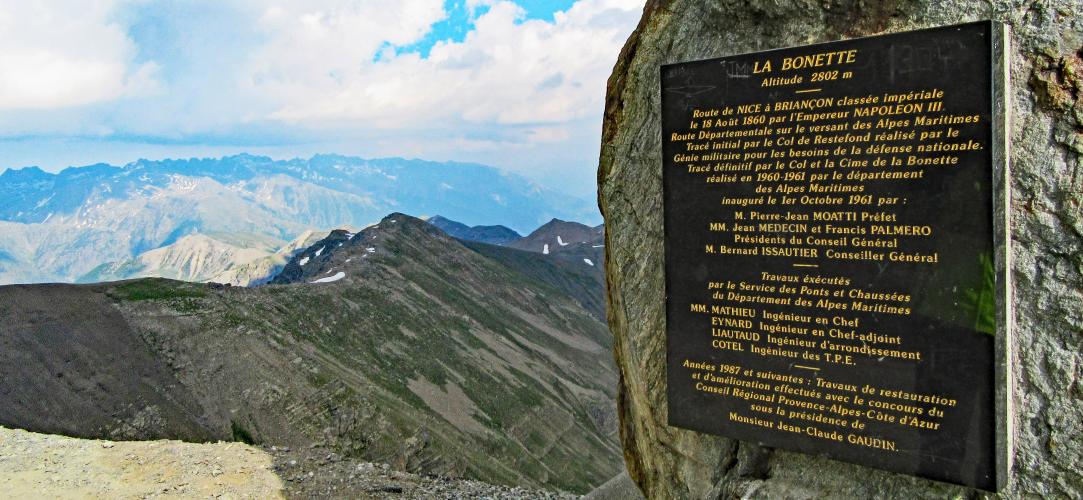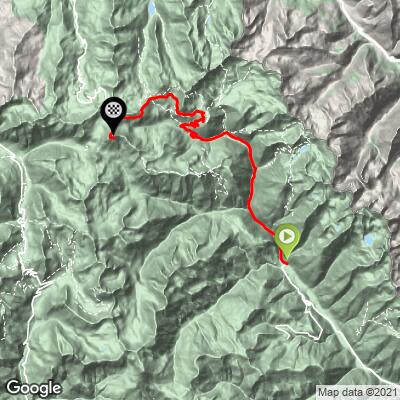![Cycling Col de La Bonette (Saint-Étienne-de-Tinée), France panoramic view shows roadside snaking and curving up mountain, green hillsides, blue sky with white clouds]()
Col de La Bonette (Saint-Étienne-de-Tinée)
25.5 km gaining 1,553 to 2,686 m finish at 6.1%
![Cycling Col de La Bonette (Saint-Étienne-de-Tinée), France photo collage shows small old mission style church, signs along climb including one for Jausiers and one for Route de la Bonette, flags for different countries line roadside]()
The approach to the col from Saint Etienne is stunningly beautiful.
The approach from Jausiers is only slightly less scenic.
Often incorrectly considered the highest road in Europe (Pico de Veleta in Spain holds that honor -- by a good stretch), this is the more challenging approach to Col de la and Cime Bonette at 23 km/1,632 m/6.9% from the north, versus 25.5 km/1,553 m/6.1% from the south. The pass itself is the third highest in Europe after Passo dello Stelvio (2760m) and Col de L’Iseran (2770m), but if we take the loop to Cima Bonette at the pass, we gain another 81m, which tops out above L’Iseran.
![Cycling Col de La Bonette (Saint-Étienne-de-Tinée), France climb start in Etienne-de-Tinee, lush greenery surrounds roadways, many roadsigns including those reading "Attention, Course Cycliste"]()
The climb begins in Saint-Étienne-de-Tinée (2008 population 1,324).
![Cycling Col de La Bonette (Saint-Étienne-de-Tinée), France photo collage shows kilometer markers along the climb]()
Kilometer markers along the entire climb.
Col de la Bonette is located in the French Alps near the border with Italy. It is located within Mercantour National Park (established 1979; 169,000 acres), between the Ubaye Valley and the valley of the Tinée River. As with many French/Italian passes, there are military remnants along our climb to the top. Col de la Bonette is the second highest paved route through the Alps (the summit is at 2,802 m/9,193’). You can read more about Col de la Bonette and the surrounding area here.
![Cycling Col de La Bonette (Saint-Étienne-de-Tinée), France small village near top of climb, includes old stone buildings, Gite d'etape communal de Bousieyas]()
Be sure to stop at the very scenic village at the 12 kilometer mark up the mountain
and have a snack, drink or sandwich at Gite d’etape communal de Bousieyas.
![Cycling Col de La Bonette (Saint-Étienne-de-Tinée), France photo collage shows views along the climb, including sharp hairpin turns, smooth roadways snaking up lush green mountainsides]()
Col de Bonette is part of the Route des Grandes Alpes, a tourist itinerary that begins in Thonon-les-Bains and travels over many of the most spectacular passes in France and throughout Europe, including Col de L’Iseran, Galibier, d’Izoard, and Bonette (alternate route includes Croix de Fer and Madeleine).
![Cycling Col de La Bonette (Saint-Étienne-de-Tinée), France old military remnants of stone buildings at Camp des Fourches]()
Camp des Fourches
About 18 kilometers up the climb, as with the north side of the climb, we pass through sets of abandoned military barracks (on the south it is Camp des Fourches) which, like the northern military site, date back to the late 1800s.
![Col de La Bonette, Saint Etienne - Cima Bonette Monument PJAMM Cyclist John Johnson stands with bike at climb's summit in front of stone marker and plaque]()
Finish about 60 m above the Col at the Cime Bonette.
Col de la Bonette is located one kilometer below the high point of this road. At the col, we turn left and follow the one kilometer ascent of the Cime de la Bonette loop, gaining 80 m at 9% average grade.
Do not be confused by “Col de la Restefond” references along the northern and southern approaches to Cime de la Bonette:
Col de Restefond (el. 2,680 meters/8,790’) is a high mountain pass in the French Alps...situated on the flanks of le Restefonde within the Mercantour National Park in the department of Alpes-de-Haute-Provence. The actual pass is situated on a gravel track leading off the D64 close to its summit at the Col de la Bonette (2715 m).”
The passage over the Col de la Bonette is often mistakenly referred to as the Col de Restefond, and in the 2008 Tour de France the summit was referred to as the Cime de la Bonette-Restefond. Stage 16 of the tour approached the summit from Saint-Étienne-de-Tinée (south-east), and after reaching the Col de la Bonette, took a loop round the Cime de la Bonette reaching the summit of 2802 m, which is the highest point reached by the Tour de France,[1] before re-passing the Col de la Bonette. On the descent to Jausiers, the actual Col de Restefond was passed on the right approximately 1 km from the summit (Wikipedia).
![Cycling Col de La Bonette (Saint-Étienne-de-Tinée), France Street sign for Route de la Bonette-Restefond]()
Road sign from Jausiers.
TOUR DE FRANCE HISTORY
Cime de La Bonnette has been featured four times in the Tour de France as of 2022, and has always been the highest point on the Tour when it is featured. That is because it is the highest point the Tour has ever gone!
© Climb name | Elevation (meters) | Times highest point of TdF (as of 2022) | Mountain Range | Times Featured in Tour de France | Most recent | First included |
Cima de la Bonette | 2,802m | 4 | Alps | 4 | 2008 | 1962 |
Col de l'Iseran | 2,770m | 8 | Alps | 8 | 2019 | 1938 |
Col Agnel | 2,744m | 1 | Alps | 2 | 2011 | 2008 |
Col du Galibier | 2,642m | 50 | Alps | 63 | 2022 | 1911 |
Col du Granon | 2,413m | 0 | Alps | 2 | 2022 | 1986 |
Top five high points of the Tour de France.
Also see Top 10 Highest Points of the TdF
1962 Stage 18: 241.5 km Juan les Pins to Briancon
The tour jumped on Cima de la Bonette just two years after the road over the summit was completed. Stage 18 of the 1962 Tour de France began in the Mediterranean port town of Juan les Pins and ended 241.5 km later in the climbing hub of Briancon. Surprisingly, although the stage featured three major climbs (Bonette, Col de Vars and finally Col d’Izoard) it was Belgium sprinter Emile Daems who won the stage in a sprint over Imerio Massignan, and Jacques Anquetil sat second overall 00:01:08 back of Jozef Planckaert at the end of the day (he would gain the lead two stages later and go on to win his third of a then record five TdF championships that year).
However, fittingly, it was the great Spanish Mountain King Federico Bahamontes (The Eagle of Toledo) who was first over the inaugural ascent of Bonette, July 11, 1962, Stage 18. Bahamontes and Luis Herrera of Colombia are the only two cyclists in history to have completed the pure Grand Tour Triple Crown (KOM of the Tour de France, Giro d’Italia, and Vuelta de Espana in the same year). If not the top climber of all time, Bahamontes is in the top five: he won the mountain classification six times in the TdF, two Vuelta, and one Giro.
![]()
Federico Bahamontes was the first TdF cyclist over Col de La Bonette (1968, Stage 18)
Bahamontes was also first over Bonette in 1964, Stage 9.
Photo Bettina Verbeek, Flickr
1993 Stage 11: 179 km Serre Chevalier to Isola
On July 15, 1998, Stage 11 was won by Tony Rominger with the great Miguel Indurain (five straight TdF wins 1991-1995; two Giro 1992-1993) just behind in the same time. Click here to watch an excellent summary on YouTube by Phil Liggett.
![]()
Millar is only the second rider to lead the TdF over Col de La Bonette.
Photo - Rouleur
It was all about Scotland's Robert Millar and French great Laurent Fignon on Bonette this memorable day in the TdF, for quite different reasons. Millar took off at the beginning of the Bonette ascent in Jausiers and within a minute was 20 seconds up on climbing great Pedro Delgado. Delgado clung for a bit, but ultimately fell off and Millar topped Col de La Bonette alone. He led on the descent but was ultimately overtaken by the peloton and finished an exact one minute down to Rominger and Indurain in Isola at the finish of the stage.
Laurent Fignon (1960-2010) had an illustrious Tour career (1983-1984 TdF, 1989 Giro) which came to a bitter-sweet end on Col de La Bonette July 15, 1993 as he dropped back from the peloton and ascended Col de La Bonette alone. In his autobiography, We Were Young and Carefree: The Autobiography of Laurent Fignon, he writes, “I can remember it very clearly. I rode up the whole climb in last place. Because I wanted to. I put my hands on the top of the bars and savoured it all to the full. I was breathing deeply as I lived through my last seconds in bike racing, which i had thought would never end for me. This col was all mine and I didn’t want anyone to intrude” (Fignon 259). Sadly, it is likely due to EPO use by the majority of his serious competitors that the honorable and clean Fignon could no longer compete, though he was the best of them. Laurent Fignon died of lung cancer at the young age of 50 on August 31, 2010.
![]()
Laurent Fignon 1983-1984 TdF Champion
Photo: Velonews
2008 Stage 16: 157 km Cuneo, Italy to Jausiers, France
![]()
In 2008 Stage 16 started from St. Etienne. This stage began in Cuneo, Italy and reached Col de la Bonette via the Italian ascent and French descent of Col de la Lombarde. The stage ended in Jausiers where it was won by French climber Cyril Dessel in a sprint involving a group that broke away on the ascent of Bonette. Frank Schleck (LU) led the TdF by seven seconds over Austrian climber Bernhard Kohl.
While Stage 16 was won by Dessel and Schleck led at the end of the stage, this day in Tour history is more known for the spectacular crash of South African rider John Lee Augustyn at the beginning of the descent from the Cime de la Bonette loop road. Leading the race as it crested Bonette, Augustyn spectacularly overshot a 90 degree right hand curve and flew off the road and down a steep shale embankment (YouTube Video). Augustyn was helped back up to the road by a spectator and after checking himself and getting a replacement bike, went on to finish an amazing 35th on the stage!
![]()
John Lee Augustyn climbing back up the hillside after his tumble.
Augustyn was only the third man ever to lead the TdF over Bonette
Bahamontes (1962, 1964); Millar (1993).
Augustyn was forced to retire in May 2014 at the age of 30 due to hip damage sustained in a 2007 crash. Among other things, Augustyn now promotes his own line of cycling apparel, appropriately named . . . you guessed it: La Bonette.
(Wikipedia - Col de La Bonette)

 We've partnered with Sherpa-Map.com to bring you the best route planning tool. With a PRO Membership you can use this climb as a reference when creating your route.
We've partnered with Sherpa-Map.com to bring you the best route planning tool. With a PRO Membership you can use this climb as a reference when creating your route. 

